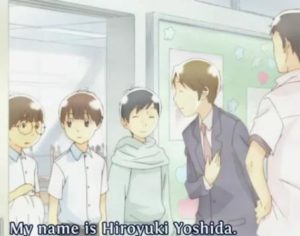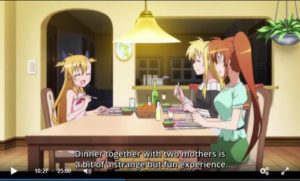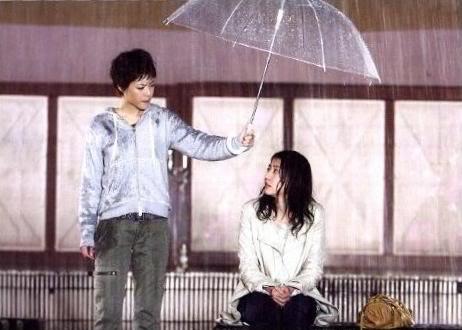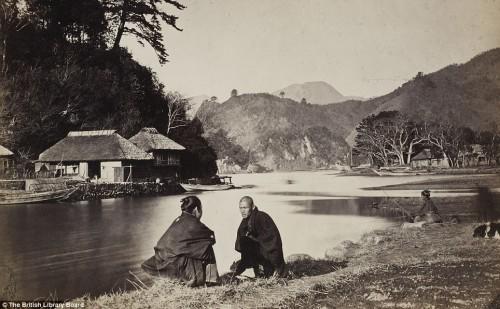It’s always a good sign when something ‘weird’ stops being funny, and is taken seriously. As it seems, that is happening – in some cases – with transgender characters in Japanese TV.
A Queer Family in Last Friends
First off, I have a correction to make. In my post on lesbians in Japan I was very dismissive of the TV drama Last Friends and its treatment of the transgender character Ruka. Her/His friends and family showed different stages of discomfort and the most accepting person, himself a rather feminine male, was in love with Ruka and thus most inclined to promise help and assistance. When asked about his/her gender and sexuality at a press conference, Ruka seemed to evade the question, and that seemed to settle the affair, burying it deep in the closet.

Since then, I have re-wtached the series several times (I wrote an essay on it) and realized that my data was SO incomplete! See, when I first watched the final episode, the file I used was corrupted, and I was missing what I assumed were merely the end credits. Turns out I also missed the entire closing sequence: Michiru names her baby after Ruka as if s/he were the father, and finally, the love triangle Michiru-Ruka-Takeru decide to live as a queer family. In the last voiceover of the series, the same Michiru who had previously rejected Ruka’s love for her, now describes their relationship as transcending established categories: Family, Friends, Husband and Wife, Lovers. We, who are none of these things, believe in moving forward as far as we can, treasuring the fragile happiness of the child. If that isn’t a radical alternative to traditional Japanese family and gender models, I don’t know what is.
The additional special episode is mostly rehashing the series, but it also makes clear that Ruka is still in a transitional stage a year later and has not simply sorted her/himself back into society as a normative man. That would be, however, what the Japanese criteria for Gender Identity Disorder describe. As portrayed in the series, the diagnosis of this condition is necessary for sex reassignment surgery,[i] which Ruka had clearly desired during the middle part of the series. I still cannot decide if keeping Ruka ambiguous is a progressive statement for a more fluid view of gender, or a move by the producers to avoid having him portrayed as an actual transman.
Be that as it may, the impact of the series’ progressive view on gender and family seems to have been comparatively small. I couldn’t find any magazine articles discussing this aspect, and Japanese acquaintances also remembered it more for its treatment of domestic violence (main character Michiru is treated savagely by her boyfriend Sōsuke) then for the gender issues discussed. However, in this interview (Japanese, no subtitles), Last Friends is positively mentioned as an example of TV acting as ‘education’, informing the public about the existence of lesbians and MTF-transgender people. As the gender researcher Mitsuhashi Junko (at least I think that’s how her name is read) points out, ‘the worst discrimination is if something is thought to not exist’.[ii] So, Last Friends plays an important role in making non-heteronormative gender visible – even if it is unclear about the position of Ruka as lesbian, FTM trans, or non-binary trans. By contrast, Wandering Son makes very clear what identity issue the protagonists face.
The troubles of transgender teenagers – Wandering Son
Hōrō Musuko (Wandering Son) is a 2011 anime, broadcast on Friday nights at Fuji TV. Adapting parts of Shimura Takako’s manga, in eleven episodes it portrays a group of middle school students struggling with first love, peer pressure, and gender expectations. The two main characters, Nitori Shūichi, assigned male at birth, and Takatsuki Yoshino, assigned female, both identify as the ‘opposite’ gender. The series shows Nitori’s struggles as she is rejected and insulted by her sister for putting on the sister’s frilly dress.

Kimochi warui, the phrase that haunts Nitori in the following sequence, can mean anything from merely ‘uncomfortable’ to ‘revolting’ or ‘disgusting’ and is therefore a good example of the gut reaction many Japanese used to have to non-heteronormative gender expression. According to Sugiura Ikuko, 62% of the male and 51% of the female participants in a 2000 survey thought homosexuality was ‘wrong‘. This might have changed in the one and a half decades since then, however, and in Hōrō Musuko, the reactions are more mixed. One the one hand, Nitori has supportive friends besides Takatsuki, and even her father understands her, to some degree. On the other hand, her sister Maho struggles and often fails to understand Nitori. Maho represents the clash between an entrenched traditional, gender-normative worldview, which is appaled by transgressors such as Nitori, and genuine sisterly love for her sibling. For example, she tries to apologize by giving one of her fried shrimps to Nitori at dinner, yet gets irritated quite easily again at Nitoris next ‚offense‘. No doubt this is partially due to Maho’s fear of the social consequences, not only for Nitori but (mostly) for herself. She does not want to be linked to a transgressor and share the blame and bullying that is to be expected once Nitori comes out.
In the climactic sequence where Nitori finally comes out by going to school dressed as a girl, the inherent misogyny of Japanese (and western) society is demonstrated. Girls wearing boy’s uniforms to school, like Takatsuki and Chi-chan, are considered cool, but when Nitori arrives in a skirt and wig, she is taken to the infirmary, her parents are called, and she is bullied by her classmates for some time afterward. Masculinity is prestigious, so girls aspiring to it are (to some degree) acceptable. But femininity is designated low-status, so a boy wanting to be a girl is considered sick (hence infirmary) and a delinquent (hence calling the parents). ‘In [western] culture, one of the most common and severe ways one can insult a man is to tell him that he’s acting like a girl — that he’s weak, emotional, prissy, or feminine. […] Too often, men are told that their worth depends on how well they can conform to masculine ideals, and that stereotypically “feminine” behaviors therefore devalue them.’ [iii] Japanese culture works in a similar way, it seems.

As I mentioned above, Nitori and Takatsuki are supported by a circle of (to varying degrees) accepting friends. Takatsuki (and later Nitori too) also consult the adult transwoman Yuki as a confidante and mentor. Yuki lives with a male partner and is feminine in voice and appearance, yet introduces herself as ‘okama’ (derogatory term for an effeminate male homosexual) to a classmate of Nitori. This suggests she has not fully transitioned or (perhaps like Ruka in Last Friends?) that she rejects the heteronormative view of transpeople as someone you operate and then slot back into society as a ‘normal’ man or woman.

For example, when Nitori and Takatsuki’s school stages a gender-swap play, Yuki goes so far as to go ‘double-drag’, wearing her last remaining masculine attire, a formal suit, and introducing herself with her full (masculine) name to the students she meets. Yuki’s feminine performance and her (in this moment) masculine appearance cause confusion, and her partner criticizes her for that. Yet she mostly receives the same response Chi-chan and Takatsuki get for wearing boys’ uniforms: The feminine person in (prestigious) masculine dress is admired as cool. In this case, however, the person was actually male to begin with. This reveals how ridiculous societal judgements and gender-biased expectations are in the first place.
Coda: The Future Starts Now
While Last Friends opens up the possibility of a non-heteronormative family and implicitly (whether intentional or not) rejects binary concepts of gender and sexuality, Wandering Son exposes the emotional cost of gender stereotypes to both transpeople and their families, as well as the arbitrariness of gender-based value judgements. As such, the series has attracted attention among western audiences (boasting eight video reviews on youtube and a 4.6 out of 5 rating on Crunchyroll, for example). In Japan, it was broadcast late at night, though. The implication is, probably, that Hōrō Musuko is a programme not intended for children, which is sad, since it bears the potential to alert people to harmful gender stereotypes at a young age.

Nevertheless, the existence of anime and TV-dramas featuring non-normative characters makes these issues visible which have long been silenced in Japanese society. Perhaps we are entering an age of more open discussion, leading to eventual change? Let’s hope for a future where queer families are as normal as the one in Magical Girl Lyrical Nanoha Vivid – but without the sexism featured in that series, as I pointed out previously.
Notes and References:
[i] Nicola McDermott, ‘Resistance and Assimiliation: Medical and Legal Transgender Identities in Japan’, in Manga Girl Seeks Herbivore Boy: Studying Japanese Gender at Cambridge, ed. by Brigitte Steger et al (Zurich: Lit Verlag, 2013), 3, pp. 177–226.
[ii] See also Ikuko Sugiura, ‘Increasing Lesbian Visibility’, in Transforming Japan: How Feminism and Diversity are Making a Difference, ed. by Kumiko Fujimura-Fanselow (New York: The Feminist Press at the City University of New York, 2011), pp. 164–76, p. 172.
[iii] http://www.bustle.com/articles/115512-8-ways-men-dont-realize-they-are-subtly-shaming-women?utm_source=facebook&utm_medium=owned&utm_campaign=bustle. I know I read more about this somewhere else, but sadly, I didn’t make a note of it at that time, so now I can’t give you the source.



